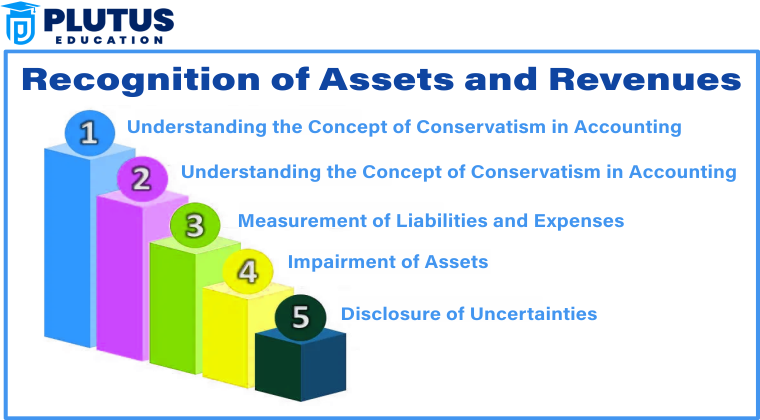Conservatism in accounting is a principle intended to guide the practitioner toward being conservative overestimates and, consequently, all related decisions about the financials. The heart of the conservatism concept is to recognize expenses and liabilities when it becomes reasonably possible to do so but only revenues and assets when sure. Such prudent practice would make it impossible for financial statements to project an overly optimistic view regarding the health of a company. It essentially aims to avoid overstatement by being on guard over profits and wary of losses.
What is Conservatism Concept?
Conservatism is an accounting principle of prudence and caution. Thus, accountants must be in a position to anticipate the loss but should not have a preposition of getting profits unless it is certain. Expenses and liabilities will be recorded upon a reasonable possibility of obtaining them while revenues and assets are to be recognized upon their confirmation. This way, it is always too much to suppress overestimation of the financial position of a business while risking the expression of financial statements more conservatively.

How Accounting Conservatism Works
The conservatism concept is applied throughout the accounting process, influencing both the recognition and measurement of financial items.
Revenue Recognition
Revenue is recognized only when earned and reasonably assured. For example, if a firm makes sales whose collection involves considerable uncertainty, then the revenue would not be recognized immediately.
Expense Recognition
On the other hand, expenses are recognized when there is a probable occurrence that the expense will be incurred and not paid. Thus, it prevents the liabilities of the company from underestimation.
Asset Valuation
Conservatism affects the value of assets because businesses have to report the lower value as either cost or market value. For instance, when the value of inventories declines, then that firm has to write down its value, but an increase in value is not recognized before it is realized.
Example of Conservatism in Action
Consider a company facing a lawsuit. Although the case outcome is unknown, conservatism dictates that the company must record a contingent liability if there is a reasonable possibility of loss. However, if the company believes it will win the case and recover damages, then this potential gain will not be recorded until it is almost certain.
Application of Conservatism in Financial Reporting
The conservatism concept is applied in various aspects of financial reporting, ensuring that financial statements are not overly optimistic.
Impairment of Assets
Conservatism principle in impairment of assets In the conservatism principle, impairment has to be written down or assessed in assets. The impairment loss is realized whenever the market value of an asset declines below its carrying value on the balance sheet.
Inventory Valuation
In conservatism, inventories have to be carried at a lower cost and market. It will account for all forms of losses when the market reduces the value of the inventory.
Provisioning for Bad Debts
Companies are required to create provisions for bad debts even when the exact amount of loss is uncertain. This ensures that any potential loss in the value of receivables is reflected in the financial statements.
Advantages of the Conservatism Concept
The conservatism concept provides several advantages for companies, investors, and stakeholders by promoting caution and realism in financial reporting.
- Protects Stakeholders: It protects stakeholders since conservatism does not overstate income and assets. Thereby giving stakeholders like investors and creditors a better view of the company’s financial health.
- Reduces Overstatement Risks: In industries that are sensitive to market fluctuations, the concept of conservatism reduces the risks of overstating profits or assets that may fluctuate unpredictably. This results in more sustainable financial decisions.
- Encourages Prudent Decision-Making: It fosters conservative decisions. Conservatism forces the management to be more careful whenever it has to decide since it offers to provide for prospective losses earlier than benefits will come, and thus there would be an encouragement to reduce or defeat risks before they arise.
- Improves acceptability: Under conservatism, the accounting statements look creditable as no inflations exists for the earning figures nor fail to provide for liabilities as a result, and this gives grounds for having great confidence in the investors.
Disadvantages of Conservatism Principle
Despite its advantages, the conservatism concept has some drawbacks that may lead to issues in financial reporting.
- Understates Profits and Assets: It tends to understate profits and assets. Conservatism often underestimates the assets and profits, which means that the company will look less profitable than it is.
- Potential to mislead: on the negative side, the conservative principle sometimes yields an almost too pessimistic company-specific impression regarding its level of health in terms of finances. Sometimes, potential investors could take this negatively as assuming the company in question has actually performed deplorably while it really only tends to be safe on its end.
- Discourages Risk Taking: The overemphasis on conservative reporting discourages companies from pursuing growth opportunities since the potential gains are only recognized when certain, thereby delaying investment decisions.
| Disadvantages | Details |
|---|---|
| Understates profits/assets | Can lead to undervaluation of the company’s financial performance |
| Potentially misleading | May result in financial statements that are too pessimistic |
| Discourages risk-taking | May slow down growth or investment opportunities due to overly cautious reporting |
Consistency plays a significant role in accounting as it ensures firms are cautious while reporting on profits, assets, or liabilities. Even though it eliminates overstatements and leads to an increase in confidence by investors, it will lead to understatements as regards the state of any firm’s health. Since prudent financial reports that are conservative, yet reliable, make sure that it is often done at the expense of optimism. Therefore, a business needs to maintain a balance between caution and the desire for a correct portrayal of their financial performance.
Conservatism Concept FAQs
How does the conservatism principle affect financial statements?
The conservatism principle leads to earlier recognition of expenses and liabilities, while revenues are recognized only when they are assured, ensuring a cautious financial outlook.
Why is conservatism important in accounting?
Conservatism is important as it prevents the overstatement of a company’s financial health, thus protecting investors and stakeholders from overly optimistic projections.
Can conservatism lead to inaccurate financial reporting?
Yes, overly conservative reporting can sometimes result in the understatement of profits and assets, which may mislead stakeholders into believing a company is underperforming.
How does conservatism relate to inventory valuation?
Under the conservatism principle, inventory is valued at the lower of cost or market price to ensure that any decline in market value is promptly reflected in the financial statements.
What is a common criticism of the conservatism concept?
A common criticism is that it can make financial statements too pessimistic, potentially leading to missed opportunities or unnecessary investor concern.


